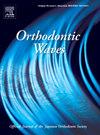Extractions in the setting of facial harmony in adolescents with bimaxillary protrusion: a retrospective cohort study
IF 0.5
Q4 DENTISTRY, ORAL SURGERY & MEDICINE
引用次数: 2
Abstract
ABSTRACT Purpose The objective of this study was to assess the importance of orthodontic extractions in the setting of facial harmony to adolescents with bimaxillary protrusion. Material and methods: The orthodontic files of 73 adolescents with incisors protrusion treated with or without premolar extractions were studied on pre- and post-treatment facial photographs in a retrospective cohort study, while dental casts of 69 were assessed. The best-fit template of normal proportions was superimposed to the photograph and the facial harmony scores were obtained, while the DAI (dental aesthetic index) was studied in the models. Intra- and intergroup statistical comparisons and the index of improvement were determined. Results: The groups demonstrated significant change of lips positioning, though extraction group reached relative higher index of improvement. There was significant improvement in the labiomental groove position only for the extraction group in a profile view. Generally, a high success rate of dental relationships was found in the DAI. Conclusions: Both treatment protocols reached significant improvement of facial harmony. Orthodontic extractions of premolars might be related to establishing normal occlusion in cases with bimaxillary protrusion, while preventing worse hyperactive mental muscle when the arch discrepancy is negative. Abbreviations: 1-NA: Upper incisors cephalometric protrusion in millimetres; 1-NB: Lower incisors cephalometric protrusion in millimetres; AIR: Alare at right side; Al: Alare; AlL: Alare at left side; Ch: Cheillion; ChL: Cheillion at left side; ChR: Cheillion at right side; DAI: Dental Aesthetic Index; Ex: Exocanthion, posterior contour of the Orbitale; G: Glabela; Li: Inferior Lip; Ls: Superior Lip; Me: Menton; Msw: Midpoint of the craniofacial depth; OA: Anterior contour of the Orbitale; Ocp: Occipital; OL: Lower contour of the Orbitale; OU: Upper contour of the Orbitale; PLL: Pupil at left side; PLR: Pupil at right side; Pog: Pogonion; Sm: Labio-mental sulcus; Sn: Subnasale; Tr: Trichion; V: Vertex; ZyL: Zygion at left side; ZyR: Zygion at right side青少年双颌前突患者面部和谐情况下的拔除:一项回顾性队列研究
摘要目的本研究的目的是评估正畸拔除在双上颌前突青少年面部和谐环境中的重要性。材料和方法:在一项回顾性队列研究中,对73名接受或不接受前臼齿拔除治疗的门牙突出青少年的正畸档案进行了治疗前和治疗后的面部照片研究,并对69名青少年的牙模进行了评估。将正常比例的最佳拟合模板叠加到照片上,获得面部和谐评分,同时在模型中研究DAI(牙齿美学指数)。确定组内和组间的统计比较和改善指数。结果:两组的嘴唇位置发生了显著变化,但拔牙组的改善指数相对较高。在侧位图中,只有拔除组的唇沟位置有显著改善。一般来说,在DAI中发现牙科关系的成功率很高。结论:两种治疗方案均能显著改善面部和谐。在双上颌前突的病例中,前磨牙的正畸拔除可能与建立正常的咬合有关,同时在足弓差异为阴性时防止更严重的过度活跃的精神肌肉。缩写:1-NA:上切牙头影测量突出量,单位为毫米;1-NB:下切牙头影测量突出量,单位为毫米;AIR:ARE在右侧;Al:阿拉雷;AlL:左侧为Alare;Ch:Chelion;ChL:左侧切利翁;ChR:右侧切利翁;DAI:口腔美容指数;Ex:外眼角,眼眶后轮廓;G: 格拉贝拉;李:下唇;Ls:上唇;我:芒通;Msw:颅面深度的中点;OA:眼眶前轮廓;Ocp:枕骨;OL:轨道飞行器的下轮廓;OU:轨道飞行器的上轮廓;PLL:左侧瞳孔;PLR:右侧瞳孔;Pog:Pogonion;Sm:Labio精神沟;Sn:鼻下;Tr:Trision;V: 顶点;ZyL:左侧的Zygion;ZyR:右侧的Zygion
本文章由计算机程序翻译,如有差异,请以英文原文为准。
求助全文
约1分钟内获得全文
求助全文
来源期刊

Orthodontic Waves
DENTISTRY, ORAL SURGERY & MEDICINE-
CiteScore
0.40
自引率
0.00%
发文量
0
期刊介绍:
Orthodontic Waves is the official publication of the Japanese Orthodontic Society. The aim of this journal is to foster the advancement of orthodontic research and practice. The journal seeks to publish original articles (i) definitive reports of wide interest to the orthodontic community, (ii) Case Reports and (iii) Short Communications. Research papers stand on the scientific basis of orthodontics. Clinical topics covered include all techniques and approaches to treatment planning. All submissions are subject to peer review.
 求助内容:
求助内容: 应助结果提醒方式:
应助结果提醒方式:


